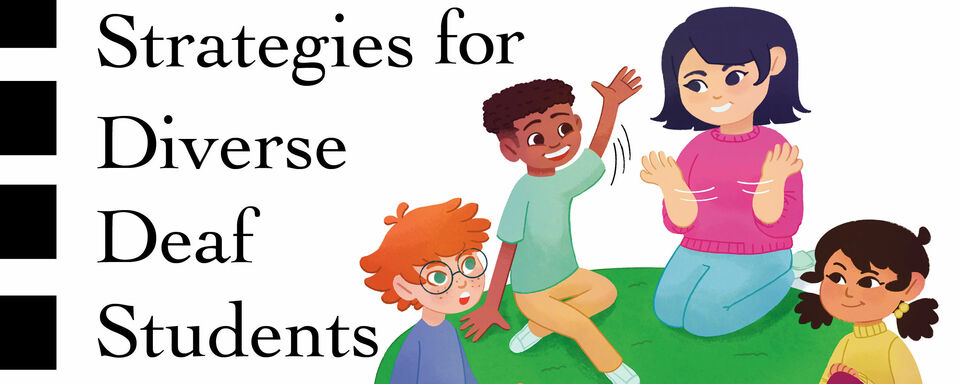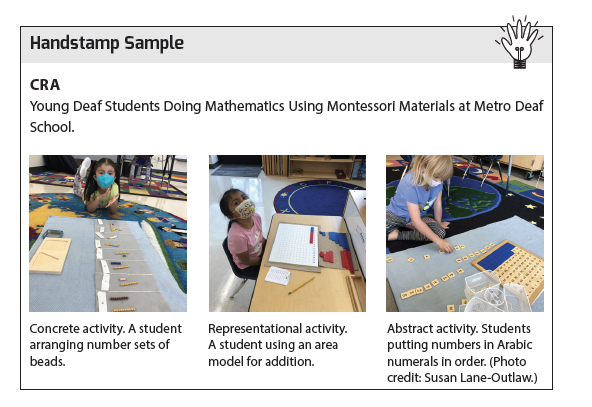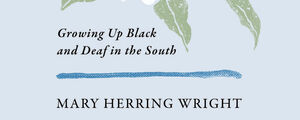
Creating an Inclusive Classroom Environment for Deaf Kids
58-IN-MIND: Multilingual Teaching Strategies for Diverse Deaf Students is a foundational resource for educators working with Deaf students that offers concrete information on how to incorporate Deaf-centered strategies in the classroom. In this blog post, editors Debbie Golos, Marlon Kuntze, Kimberly Wolbers, and Chris Kurz have selected key excerpts from the book to showcase its unique contribution.
58-IN-MIND - What does it mean?
In creating the title of the book, we drew on an ASL sign that reflects the goal of the book, which is for teachers to use the practices discussed across the chapters to positively impact their students’ learning. The number 58, because of the way it is signed, is a playful way to transcribe the ASL sign for stick. The phrase “58-IN-MIND” in the title refers to the version of the sign for stick that is made on the forehead, which is equivalent to the English idiom “stick in one’s mind.” In short, when learning is delivered in a culturally responsive manner, it is more likely to stick. The sign "58-IN-MIND" also alludes indirectly to the collective aspirations of the chapter authors that the practices discussed in the book will also stick in the readers’ minds and have a transformative impact on the way we collectively teach Deaf students.
Why is this book different?
58-IN-MIND incorporates recent research, emerging evidence of what works in the classroom (ecological validity), and the drive to make education as equitable as possible for each child. Our intention here is to provide a methods book that is engaging to read as well as practical. We need a book that recognizes the diversity of Deaf students and strives to align the field with best practices that are embedded in social-emotional, cultural, linguistic, and intellectually sustainable approaches to learning. The book aims to help both current and future teachers provide meaningful education for Deaf students from early education through high school. Although each chapter can be read independently, it is our hope that instructors in teacher preparation programs will require the reading of all the chapters. We also encourage teachers already working in the field to review as many chapters as possible because there are strategies in varying subject areas, even those outside their content areas, they may be able to tap into in their teaching.
Ideas and perspectives shared in the book also have the potential to offer general education teachers innovative tools for reaching a diverse body of students. We believe that teachers who teach hearing children can benefit from the methodologies discussed in this book. Children in general are diverse, and all teachers may struggle with meeting the needs of individual students. Learning that is visually based and builds on students’ strengths, backgrounds, languages and cultures can benefit many students, whether or not they are Deaf.
In preparing this book, the coeditors drew from their experiences both as kindergarten through Grade 12 teachers and college educators. Each chapter is coauthored by at least one researcher and one P–12 teacher, with at least one of the authors being Deaf. The authors combine experience, time-tested practice, and research into each chapter to produce a book that shares perspectives, examples of lessons, and real stories from those working in the field from preschool through age 21 (and transition ages). Although the targeted readers are preservice teacher candidates, in-service teachers, and faculty and instructors who teach methods courses, we also believe that educational researchers, school administrators, content coaches, specialists, and others can benefit from this book.
Meet the editors in this video!
Why focus on multilingual teaching strategies?
One theme that recurs throughout all chapters echoes the need for teachers to create an environment that ensures high-quality communication in the classroom. A language that is fully accessible is a necessary condition for making communication high quality. It is one of the reasons why it is important to make ASL available for Deaf children. A vast majority of Deaf children come to school with limited ASL skills. Teachers need to meet each child where they are when they arrive in their classroom. It is not only how they can best support Deaf children’s language development but also how they can ensure that communication is happening. High-quality communication between teachers and their students is mandatory in order for the teachers to learn what their students already know, the nature of how they have come to understand the content, what it is about the content that is still not clear to them, and how to engage each student in learning. This will also help teachers decide what to pull from their toolbox of multilingual and multimodal strategies discussed within and across chapters of the book and determine how to best use them to deliver instruction. Ultimately, when you build on the foundation of Deaf-centered instruction, as conveyed by this book in ways that connect with the full spectrum of diverse Deaf identities, you will provide education that is not only equitable but will result in learning that sticks for all students.
An excerpt from the chapter "Mathematics"
Key Strategy
Concrete–Representational–Abstract (CRA) Approach
Here is a multiple representation strategy that has become popular in STEAM (science, technology, engineering, arts, mathematics) classrooms (Hughes et al., 2014), and can be beneficial to Deaf students. With this strategy, representations can be depicted concretely (C, using real objects), representationally (R, using images/illustrations), and/or abstractly (A, using symbols and words in ASL, English, and additional home languages when possible). You can set up learning stations to allow opportunities for teaching and practicing math using these different representations. For example, you can set up one station with manipulatives (e.g., counters, linking cubes, base 10 blocks), one station with pictorial forms (e.g., number lines, ten frames, arrays, base 10 shorthand, hundred grids), and another station with sign and print languages (e.g., flashcards with English words and/or ASL words, standard notations, and standard algorithms). You can also add students’ home languages as well on the cards (e.g., Spanish, Mexican Sign Language/Lengua de Señas Mexicana [LSM]).
Above is an example of Stick It Into Action!, a section found throughout the book where the authors provide readers with an example of how to apply the material to their own teaching.
Handstamp Samples are incorporated across the chapters to show real-life examples of student work.
Looking for more information about 58-IN-MIND? Click here to visit our Manifold multimedia site for a full chapter excerpt, signed video content, and additional resources!






Comments